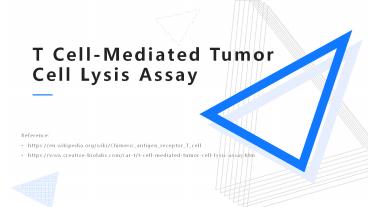tumor cell lysis - PowerPoint PPT Presentation
Title:
tumor cell lysis
Description:
The target tumor cells are labeled with specific fluorescent cytoplasmic reagent, the live cells can be imaged and monitored at real-time level to measure the tumor cell lysis. The reagent is safe for cells at optimized concentration, and fluorescence measurements can be accurately performed for short-term experiments, as the reagent will be diluted with cell proliferation. In addition, the ratio of target tumor cells and CAR-T cells can be optimized in the assay. – PowerPoint PPT presentation
Number of Views:43
Title: tumor cell lysis
1
T Cell-Mediated Tumor Cell Lysis Assay
- Reference
- https//en.wikipedia.org/wiki/Chimeric_antigen_rec
eptor_T_cell - https//www.creative-biolabs.com/car-t/t-cell-medi
ated-tumor-cell-lysis-assay.htm
2
Background
- Chimeric antigen receptors (CARs, also known as
chimeric immunoreceptors, chimeric T cell
receptors or artificial T cell receptors) are
receptor proteins that have been engineered to
give T cells the new ability to target a specific
protein. The receptors are chimeric because they
combine both antigen-binding and T-cell
activating functions into a single receptor. - CAR-T cell therapy uses T cells engineered with
CARs for cancer therapy. The premise of CAR-T
immunotherapy is to modify T cells to recognize
cancer cells in order to more effectively target
and destroy them. Scientists harvest T cells from
people, genetically alter them, then infuse the
resulting CAR-T cells into patients to attack
their tumors.
3
- Anti-tumor activity in mice is induced only when
both the universal CAR T cells plus the correct
antigen-specific adaptor molecules are present.
Anti-tumor activity and toxicity can be
controlled by adjusting the administered adaptor
molecule dosing. Treatment of antigenically
heterogeneous tumors can be achieved by
administration of a mixture of the desired
antigen-specific adaptors. Thus, several
challenges of current CAR T cell therapies, such
as - the inability to control the rate of cytokine
release and tumor lysis - the absence of an off switch that can terminate
cytotoxic activity when tumor eradication is
complete - a requirement to generate a different CAR T cell
for each unique tumor antigen - may be solved or mitigated using this approach.
4
Two Assays for T Cell-Mediated Tumor Cell Lysis
- The target tumor cells can be incubated with the
radiolabel. The specific radiolabel is taken up
and reversibly binds to cytosolic proteins. When
the target cells are recognized by CAR-T
lymphocytes, the target cells are killed and the
radiolabel is released.
5
Two Assays for T Cell-Mediated Tumor Cell Lysis
- The target tumor cells are labeled with specific
fluorescent cytoplasmic reagent, the live cells
can be imaged and monitored at real-time level to
measure the tumor cell lysis. The reagent is safe
for cells at optimized concentration, and
fluorescence measurements can be accurately
performed for short-term experiments, as the
reagent will be diluted with cell proliferation.
In addition, the ratio of target tumor cells and
CAR-T cells can be optimized in the assay.
6
(No Transcript)
7
Thanks
- Reference
- https//en.wikipedia.org/wiki/Chimeric_antigen_rec
eptor_T_cell - https//www.creative-biolabs.com/car-t/t-cell-medi
ated-tumor-cell-lysis-assay.htm































